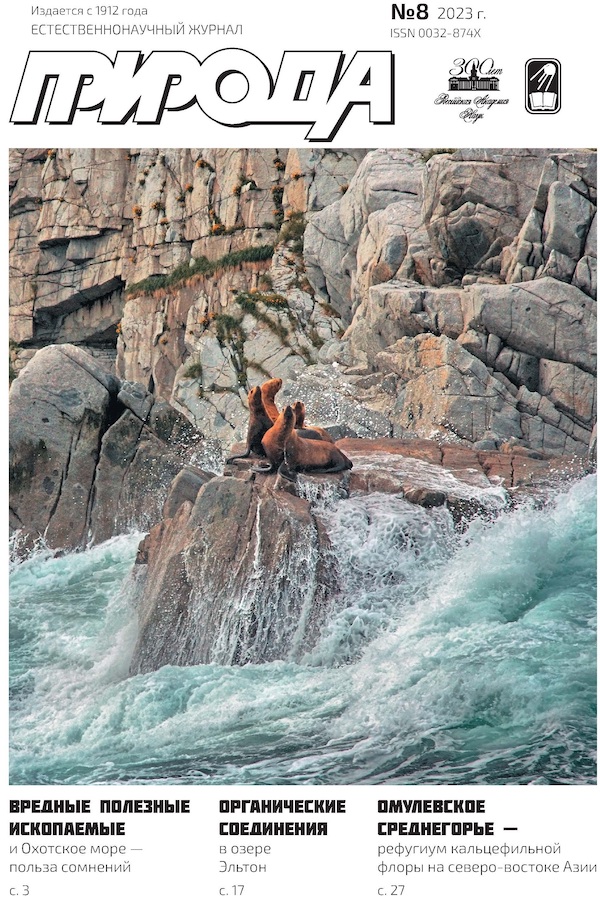Omulevka Middle-Mountain Region as a Refuge of the Calcicole Flora in Northeast Asia
- Autores: Khamenkova E.V1, Khoreva M.G1
-
Afiliações:
- Institute of Biological Problems of the North, Far Eastern Branch of the Russian Academy of Sciences
- Edição: Nº 8 (2023)
- Páginas: 27-37
- Seção: Articles
- URL: https://journals.eco-vector.com/0032-874X/article/view/627826
- DOI: https://doi.org/10.7868/S0032874X23080033
- ID: 627826
Citar
Texto integral
Resumo
In Northeast Asia, calcicolous plants are relatively rare, since the predominant rocks are poor in carbonates. In this regard, the Omulevka middlemountain region composed of Paleozoic limestones and located in the upper reaches of the river with the same attracts especial attention. In 2022, a signifi cant part of the area was included into the Andreev Chersky National Park. Due to its remoteness and lack of roads, the botany studies in the middle mountain region are insuffi cient. In 2023, the expedition on an off -road vehicle covered more than 1000 km throughout the park. The preliminary processing of the collected botanical samples allows us to consider the Omulevka middle-mountain region as a refuge of calcicole fl ora. Among more than 300 species of vascular plants typical for the forest part of northeastern Asia, about 20–25 turned to be pronounced (or even obligate) calcicole species. Almost all of them are rare in the Magadan Region, but in the National Park they are not merely common, but numerous. Some of them (Rhododendron adamsii, Chrysanthemum mongolicum, Leontopodium villosulum, etc.) practically form fi elds along low pebble river terraces. Approximately half of the calcicole species have status of regionally protected species, and one — the federal status. Further studies are expected to be very fruitful.
Palavras-chave
Sobre autores
E. Khamenkova
Institute of Biological Problems of the North, Far Eastern Branch of the Russian Academy of Sciences
Email: tauy@mail.ru
Magadan, Russia
M. Khoreva
Institute of Biological Problems of the North, Far Eastern Branch of the Russian Academy of SciencesMagadan, Russia
Bibliografia
- Подробнее см.: Хаменкова Е. В. Новый национальный парк на Северо-Востоке России. Природа. 2023; 2: 48–60.
- Павлов В. Н., Хохряков А. П. К флоре Северо-Восточной Якутии. Бюллетень МОИП. Отд. биол. 1989; 94(5): 94–103.
- Красная книга Магаданской области. Редкие и находящиеся под угрозой исчезновения виды животных, растений и грибов. Магадан, 2019.
- Мазуренко М. Т. Дорогой мой ботаник. Воспоминания об Андрее Павловиче Хохрякове. 2006.
- Мерзляков В. М. Стратиграфия и тектоника Омулевского поднятия (Северо-Восток СССР). М., 1971.
- Отчет о геологической съемке и доизучения масштаба 1:200000 на площади листов Q-55-XXXY, XXXYI за 1977–1981 гг. 1982; 2.
- Sato K. Limestone vegetation of the Ohirayama Nature Conservation Area and adjacent area, Southwest Hokkaido — phytosociological study of limestone vegetation of Hokkaido Conservation reports of the Ohirayama Nature Conservation Area. Sapporo, 1987: 133–171. (In Japanese).
- Sato K. The vegetation on ultrabasic rock sites of the Apoi mountains, Hokkaido, Japan (I). A history of botanical researches and the present conditions of vegetation in the years of 2001–2002. J. Hokkai-Gakuen Univ. 2002; 114: 53–87. (In Japanese).
- Sato K. The vegetation on ultrabasic rock sites of Mt. Horomandake, Hokkaido. J. Hokkai-Gakuen Univ. 2003; 115: 15–43. (In Japanese).
- Захарова В. И. Реликтовые степные сообщества Якутии. Вестник Томского государственного университета. Биология. 2009; 2(6): 5–12.
- Андреев А. В. Каменный глухарь Tetrao urogalloides Midd. в Колымском нагорье: половой диморфизм вида и особенности биологии разнополых птиц в зимний период. Вестник СВНЦ ДВО РАН. 2017; 2: 82–94.
Arquivos suplementares









